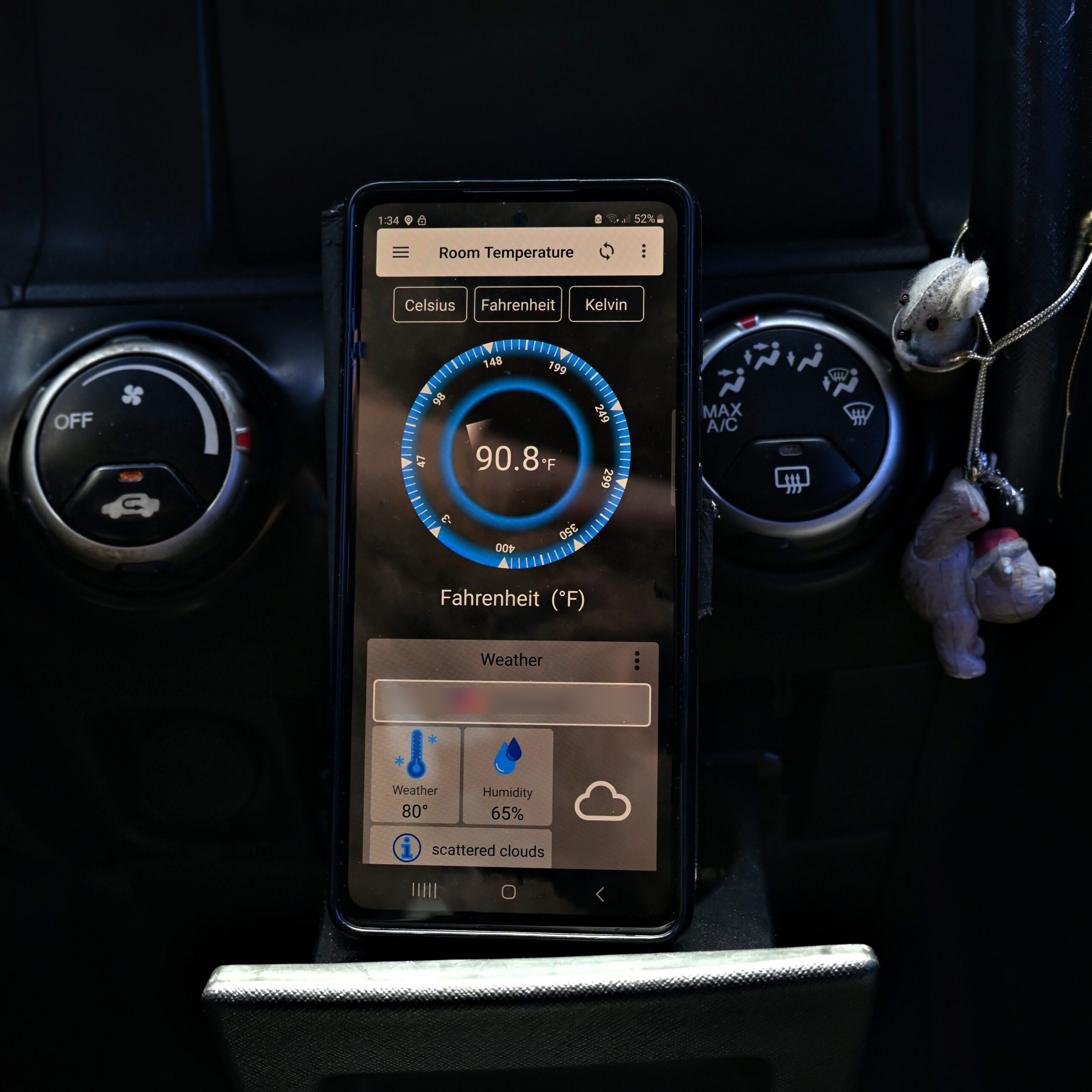Testing the Limits: My Experience with Car Air Conditioning on a Hot Day
I wanted to see if running the AC would be enough to keep the inside of my car cool while I was still inside. This was not an official test of any sort, it was simply something I tried on my own, using my own car.
I took the image shown above sitting inside my mother’s car while parked with the air conditioner running at max. The inside temperature is above 90 degrees while the outside temperature is 80 degrees. I only lasted just long enough to take this photo before it was just too hot and I had to get out.
I was really surprised running the AC didn’t cool the inside of the car down to a comfortable level. The air coming from the AC was cold at first, but within 5 min the air was getting warm, not cold, then the inside temperature started to rise.
Normally, the AC works fine, as long as the car is moving, but when parked, it doesn’t work as good. It may be just my mother’s car where this happens but I noticed it also happens with my own car which is a different make and newer.
What’s the Point?
Here in the US with record-breaking high temperatures, it’s a reminder to never leave kids, pets or anyone alone in a car if they themselves are unable to use the air conditioner or get out of the vehicle into a cool area.
We have all heard about the tragic deaths of kids and pets who suffered a fatal heatstroke in a hot car, sadly maybe you even witnessed it. It’s so easy to say, “I will only be a minute…” when the reality is in those same minutes the inside of a car is getting hotter, it only takes minutes for the interior of a car to heat up to 100 degrees or more.
Interior vehicle temperatures can reach 89 degrees Fahrenheit within 10 minutes even when the outside temperature is only in the 70’s. (Null, 2024). For a child, according to National Highway Traffic Safety Administration (NHTSA), “A Heatstroke begins when the core body temperature reaches about 104 degrees and a child can die when their body temperature reaches 107 degrees” ((NHTSA), n.d.).
As for pets, they are just as likely to suffer from a heatstroke or illness even with the windows cracked open. It’s best to leave them at home or someplace where they are cool, in a safe place with plenty of water.
So what can be done…
Cracking a window even cracking ALL the windows is not enough! It’s not nearly enough to allow the interior of the vehicle cool down enough to prevent heatstrokes.


What about leaving your EV running with the AC?
In the case for Tesla, electric vehicle environmental controls do not solve the problem. Even though an EV can run the HVAC while unattended, the system will automatically shut-off in order to conserve enough power to turn the vehicle back on. So, when the battery runs down to 20%, the system will shut-off the HVAC so the vehicle will have enough power to turn back on (Rodriguez Morrison, 2022). This means the the priority is given to the vehicle functionality not the occupants.
Worst case scenario, a child or pet is left in an EV with the environmental controls set to a comfortable level with the windows rolled up. Soon, the battery runs down and the system shuts-off, the windows are still rolled-up and the interior temperature starts to rise….quickly. Again, it only takes minutes for the interior of a vehicle to become too hot for a child, pets or even an adult to survive.
When it comes to leaving a gas-powered vehicle running with the AC, which is what I tried, the AC works for a few minutes, but eventually the car continues to heat-up. This is what happened in the two cars I tried, the results may be different for you.
That is not the only problem with a gas-powered vehicles, the ignition key needs to be left in the ignition in order for the AC to run. This creates the perfect scenario for a potential car thief who notices a running vehicle with no-one (visible) in the car.
Drivers just need to check the backseat before they leave the car

The most obvious solution is to check the back seat before you get out of the vehicle. That works as long as you remember to check the backseat. Unfortunately, some people forget about the child in the backseat especially if the child is asleep. It happens all too often. Our memories can be lacking at times even with reminders, Dr. David Diamond published an article “Children dying in hot cars: a tragedy that can be prevented” (Diamond, 2016) he explains his findings about drivers who forgot about the child in the backseat as it relates to our memories.
REMINDERS
Kids and Car Safety, a 501 (c)(3) national nonprofit is dedicated to saving the lives of children and pets in and around motor vehicles. They suggest the following recommendations as reminders to check the backseat:
“Make sure your child is never left alone in a car:
- Place the child’s diaper bag or item in the front passenger seat as a visual cue that the child is with you.
- Make it a habit of opening the back door every time you park to ensure no one is left behind. To enforce this habit, place an item that you can’t start your day without in the back seat (employee badge, laptop, phone, handbag, etc.)
- Ask your childcare provider to call you right away if your child hasn’t arrived as scheduled.
- Clearly announce and confirm who is getting each child out of the vehicle. Miscommunication can lead to thinking someone else removed the child.” – (KidsandCarSafety, n.d.)
Automakers include back seat reminders in some models
There are a few automakers that have back seat reminders to alert the driver to check the backseat. I don’t have any statistics on how well they are working, but hopefully they are exceeding expectations. However, KidsandCars Safety has 6 cases where children have died with a vehicle reminder alert in place.
Pending Legislation
There is pending legislation H.R.3164 – Hot Cars Act of 2021 introduced into congress on May 12, 2021. This legislation states, “…requires safety measures in passenger cars to reduce injuries or deaths from heatstroke and other harms to occupants of unattended vehicles.”
Your help is still needed!
The Hot Car Letter to Congress Members
KidsandCars Safety is urging people to write/email your members of congress and government officials to push the National Highway Traffic Safety Administration (NHTSA) to ISSUE A FEDERAL SAFETY STANDARD which was originally due by November 2023 as they were directed to do so by Congress. The deadline has been postponed to November 2024.
- Contact Your Members of Congress:
Go to https://democracy.io/#!/
Enter your address - Contact Government Officials:
Please email the following leaders via their email addresses provided below:
Polly Trottenberg, Deputy Secretary, The U.S. Department of Transportation (DOT)
[email protected]
Scott Goldstein, Deputy Assistant Secretary for Policy, DOT
[email protected]
Sophie Shulman, Acting Administrator, The National Highway Traffic Safety Administration (NHTSA)
[email protected]
Copy the sample letter located on KidsandCars.org into the form https://democracy.io/#!/ (please personalize your message if you wish)
The sample letter is on KidsandCars.org:
https://www.kidsandcars.org/hot-car-letter-to-congress-members
If you want to go one step further…
After seeing these tragic news stories about children and pets suffering fatal heatstroke’s in hot cars I wondered “why is this happening.” We live in a world with smartphones, smart egg trays and even smart hairbrushes that listens to your hair, and judges your brushing technique, (actually, I can probably use that). Seriously, if we can develop these products, then why don’t vehicles have built-in systems that can help detect and at the very least alert when anyone is left in a parked vehicle with rising temperatures.

Using my 20+ years of experience in technology I developed a system and method to detect vehicle occupancy. After 5 years of revisions, Patent no. 11747313 was officially granted on September 5, 2023 by the USPTO titled: Methods and systems for detection of vehicle occupancy.
The system uses various sensors to detect occupants, if a living breathing occupant is detected (as opposed to a gym bag, a box, or some other inanimate object) the system will then determine the interior and exterior environmental conditions to determine if it’s safe to run the environmental controls to bring the interior temperature down to a comfortable level. Simultaneously, it will also sound an audible alert as well as contact a pre-determine list of emergency contacts provided by the vehicle owner including 911.
There are additional patent continuations filed that also include retro-fittings for existing vehicles, AI integration, and the ability to use any combination of sensors.
The patent is now being evaluated by several companies on a non-exclusive agreement until August 2024 after which it becomes exclusive if there is an agreement to continue to the next stage of evaluation.
The IDEAL Goal
The ideal goal is to bring awareness and hopefully prevent hot car deaths by using existing technology. Whether by using simple objects and reminders for the driver or other more complex systems. If you are interested in licensing or purchasing the patent for further testing and development please contact me here: OpenDoorPathway.com/Contact/.
Let’s make hot car deaths of thing of the past.

References
(NHTSA), N. H. (n.d.). Prevent Hot Car Deaths. Retrieved from https://www.nhtsa.gov: https://www.nhtsa.gov/campaign/heatstroke
Congress, U. (2021, 5 12). H.R.3164 – Hot Cars Act of 2021. Retrieved from congress.gov: https://www.congress.gov/bill/117th-congress/house-bill/3164
Diamond, D. (2016, June 20). Children dying in hot cars: a tragedy that can be prevented. Retrieved from The Conversation: https://theconversation.com/children-dying-in-hot-cars-a-tragedy-that-can-be-prevented-60909
Hernandez, M. (2023, september 5). Patent No 11747313. Retrieved from google patents: https://patents.google.com/patent/US11747313B2/en?oq=11747313
KidsandCarSafety. (n.d.). Hot Cars Resources. Retrieved from https://www.kidsandcars.org/: https://www.kidsandcars.org/hot-cars/media-resources
https://www.kidsandcars.org/examples-of-available-technology
https://www.kidsandcars.org/hot-cars/hot-cars-federal-legislation-technology
https://www.kidsandcars.org/hot-car-letter-to-congress-members
Null, J. (2024). vehicle heating. Retrieved from https://www.noheatstroke.org: https://www.noheatstroke.org/vehicle-heating
Rodriguez Morrison, G. (2022, 10 16). Tesla Camp Mode vs Dog Mode vs Keep Climate On: What’s the difference. Retrieved from not a tesla app: https://www.notateslaapp.com/tesla-reference/949/tesla-camp-mode-vs-dog-mode-vs-keep-climate-on-what-s-the-difference
Hernandez, M. (2023). Cover Photo: Hot car interior [Photograph]
Discover more from OpenDoorPathway.com
Subscribe to get the latest posts sent to your email.


